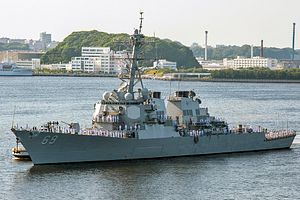The U.S. Navy’s Arleigh Burke-class guided-missile destroyer USS Milius (DDG 69) arrived at U.S. Fleet Activities (FLEACT) Yokosuka, Japan on May 22 to reinforce U.S. ballistic missile defenses in East Asia. The warship will be part of the Seventh Fleet’s so-called Forward Deployed Naval Forces in Japan.
The Seventh Fleet is the largest of the U.S. Navy’s forward deployed fleets and consists of around 50-70 ships and submarines and around 20,000 sailors. The fleet’s area of operations spans stretches from the International Date Line to the India/Pakistan border; and from the Kuril Islands in the North to the Antarctic in the South.
“Our combat system and our well-trained crew are ready to support whatever mission we are called to accomplish,” Commander Jennifer M. Pontius, commander of the USS Milius, said in a statement.
The USS Milius is the third Arleigh Burke-class guided-missile destroyer fitted with an upgraded Aegis Baseline 9 combat system to operate in the U.S. Navy’s Seventh Fleet. The Aegis Baseline 9 combat system allows the ship to simultaneously conduct air warfare and ballistic missile defense. As I explained previously:
Aegis Baseline 9, like previous Aegis variants, is an automated command-and-control (C2) and weapons control system offering integrated air and missile defense (…) capabilities to surface warships. The heart of the Aegis Combat System is the AN/SPY-1 (…) an advanced, automatic detect and track, multi-function phased-array radar system.
Aegis Baseline 9 offers a number of improvements from previous versions of the combat system (…) including simultaneous air and ballistic missile defense.
According to a Lockheed Martin representative, Aegis Baseline 9 “improves Aegis networking capabilities, allowing Aegis vessels to automatically coordinate defense with input from satellite and ground-based radar assets—forming a true shield of defense over a wide area.”
The USS Milius is armed with the Standard Missile-6, one of the U.S. Navy’s most advanced missile interceptors, capable of intercepting a ballistic missile warhead descending from the upper atmosphere at great speed, as well as the Standard Missile-3 Block IIA, capable of intercepting ballistic missiles midcourse. Both the Standard Missile-6 and Standard Missile-3 Block IIA are integral parts of the Aegis Baseline 9 combat system.
Vertically-launched from a MK 41 vertical launching system canister, the Mach 3.5+ Standard Missile-6 was originally designed for anti-air warfare and anti-surface warfare. In 2016, a Standard-Missile 6 sank the Oliver Hazard-Perry-class guided-missile frigate USS Reuben James during a test. The missile was modified in 2015 for sea-based terminal ballistic missile defense and redesignated Standard Missile-6 Dual 1.
In total, the USS Milius is equipped with 90 vertical launch system cells armed with various types of missiles for anti-air warfare, anti-submarine warfare, and anti-surface warfare missions. The guided-missile destroyer is also armed with the Phalanx close-in weapon system, Mk 141 Harpoon missile launchers, a 127-millimeter (Mk 45) lightweight gun, and MK 32 triple torpedo tubes. The warship can also carry up to two Sikorsky MH-60R helicopters.

































